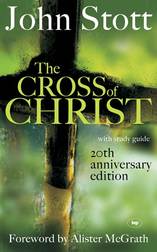The Cross of Christ

A lot of companies and brand-names have symbols or logos. McDonalds has the golden arches; the Olympics has its five rings; and Nike has its swoosh. And I guess the symbol or logo of Christianity would be the cross.
But if you pause for a moment to think about it, there is something strange about adopting a cross as your symbol. After all the cross was a particularly gruesome method of killing people. During the Roman Empire it was one of the most common methods of execution. The person to be executed would be nailed to the cross and left to die. Literally thousands of people were killed on crosses. Having a cross as the symbol for Christianity and putting it on display everywhere is like having a hangman’s noose or an electric chair, or a small guillotine hanging around your neck or on your wall. So why is the cross so important to Christianity?
In his book The Cross of Christ John Stott seeks to answer this question by exploring the nature, meaning, and significance of Christ’s death. Beginning with why the cross is so central, Stott goes on to consider the important question, “Why doesn’t God simply forgive us, without the need for a cross?” His answer is both biblically faithful and profoundly moving. But I won’t tell you what he says – I want you to read it for yourself!
A large section of The Cross of Christ concerns the “achievement” of the cross, as Stott answers the question “What did God accomplish by his self-sacrifice?”
Stott describes the achievement of the cross as threefold: rescue (or salvation), revelation, and the conquest of evil.
In the section on the salvation of the cross, Stott helpfully explains how each of the Biblical images for salvation (propitiation, redemption,
justification, and reconciliation) contributes to our understanding of the salvation Christ has won.
The final section of the book centres on the implications of “living under the cross”. Stott writes of the pervasive influence that the cross must have in every
sphere of our lives. Our self-understanding, our family relationships, and our place in society are all changed by the cross.
The Cross of Christ is a book to read slowly. It is not a “light and easy” read but it is well worth the effort. If you want to meditate more deeply on the nature,
meaning and significance of Christ’s death then this is a brilliant book. As the famous Christian writer (and prolific reader) J.I. Packer comments on the cover,
“No other treatment of this supreme subject says so much so truly and so well”.
For me, The Cross of Christ, is one of the five most significant books I have read as a Christian. I highly recommend it.
Peter Ryan
But if you pause for a moment to think about it, there is something strange about adopting a cross as your symbol. After all the cross was a particularly gruesome method of killing people. During the Roman Empire it was one of the most common methods of execution. The person to be executed would be nailed to the cross and left to die. Literally thousands of people were killed on crosses. Having a cross as the symbol for Christianity and putting it on display everywhere is like having a hangman’s noose or an electric chair, or a small guillotine hanging around your neck or on your wall. So why is the cross so important to Christianity?
In his book The Cross of Christ John Stott seeks to answer this question by exploring the nature, meaning, and significance of Christ’s death. Beginning with why the cross is so central, Stott goes on to consider the important question, “Why doesn’t God simply forgive us, without the need for a cross?” His answer is both biblically faithful and profoundly moving. But I won’t tell you what he says – I want you to read it for yourself!
A large section of The Cross of Christ concerns the “achievement” of the cross, as Stott answers the question “What did God accomplish by his self-sacrifice?”
Stott describes the achievement of the cross as threefold: rescue (or salvation), revelation, and the conquest of evil.
In the section on the salvation of the cross, Stott helpfully explains how each of the Biblical images for salvation (propitiation, redemption,
justification, and reconciliation) contributes to our understanding of the salvation Christ has won.
The final section of the book centres on the implications of “living under the cross”. Stott writes of the pervasive influence that the cross must have in every
sphere of our lives. Our self-understanding, our family relationships, and our place in society are all changed by the cross.
The Cross of Christ is a book to read slowly. It is not a “light and easy” read but it is well worth the effort. If you want to meditate more deeply on the nature,
meaning and significance of Christ’s death then this is a brilliant book. As the famous Christian writer (and prolific reader) J.I. Packer comments on the cover,
“No other treatment of this supreme subject says so much so truly and so well”.
For me, The Cross of Christ, is one of the five most significant books I have read as a Christian. I highly recommend it.
Peter Ryan

